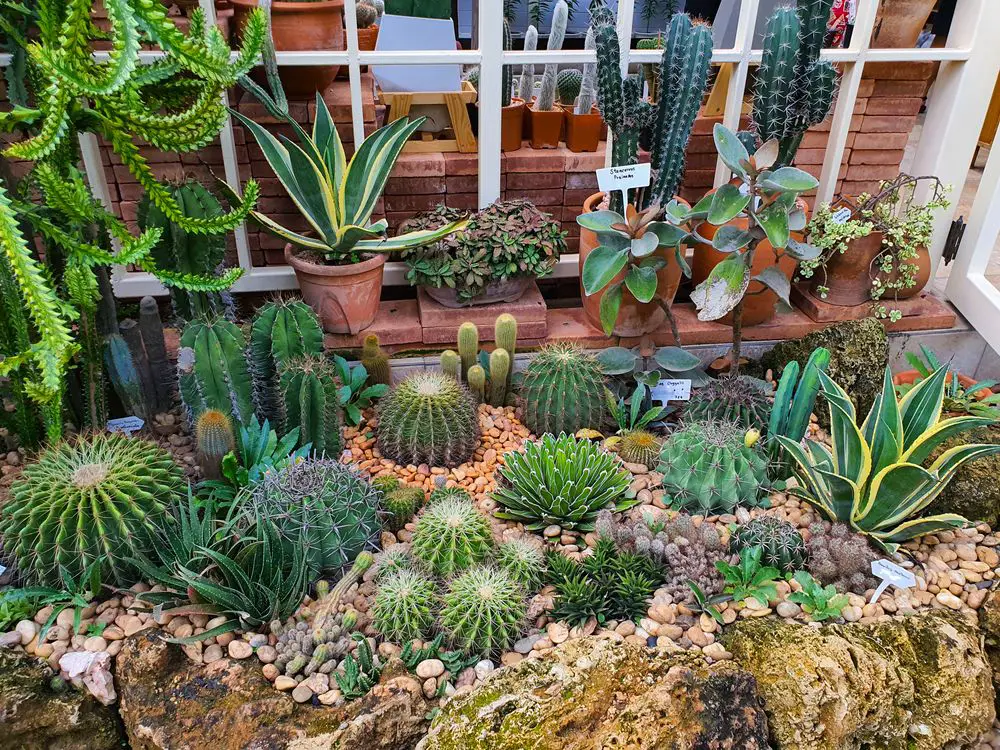Succulents are gorgeous. They are one of the most popular home and office plants. They can, however, be a challenge to grow when you lack a bright, sunny location because most of these species need a lot of sunlight. However, there are low light succulents….
The 21 low light succulents are: Echeveria, Snake Plant, Ox Tongue Plant, Lance Aloe, Zebra Haworthia, Panda Plant, String of Pearls, String of Hearts, String of Bananas, Burro’s Tail, Holiday Cactus, Wax Plant, Bear Paws, Jade Plant, Mother-in-Law’s Tongue, Zebra Cactus, Ponytail Palm, Mistletoe’s Cactus, Green Ice, Aloe Vera, Happy Bean. Plus, Care Tips in detail, below…
Low Light Succulents
Succulents are low in maintenance but usually need lots of sunlight to grow and thrive.
However, good news! There are low light succulents that can grow and thrive even in low light conditions. Here are 21 of them:
1. Echeveria
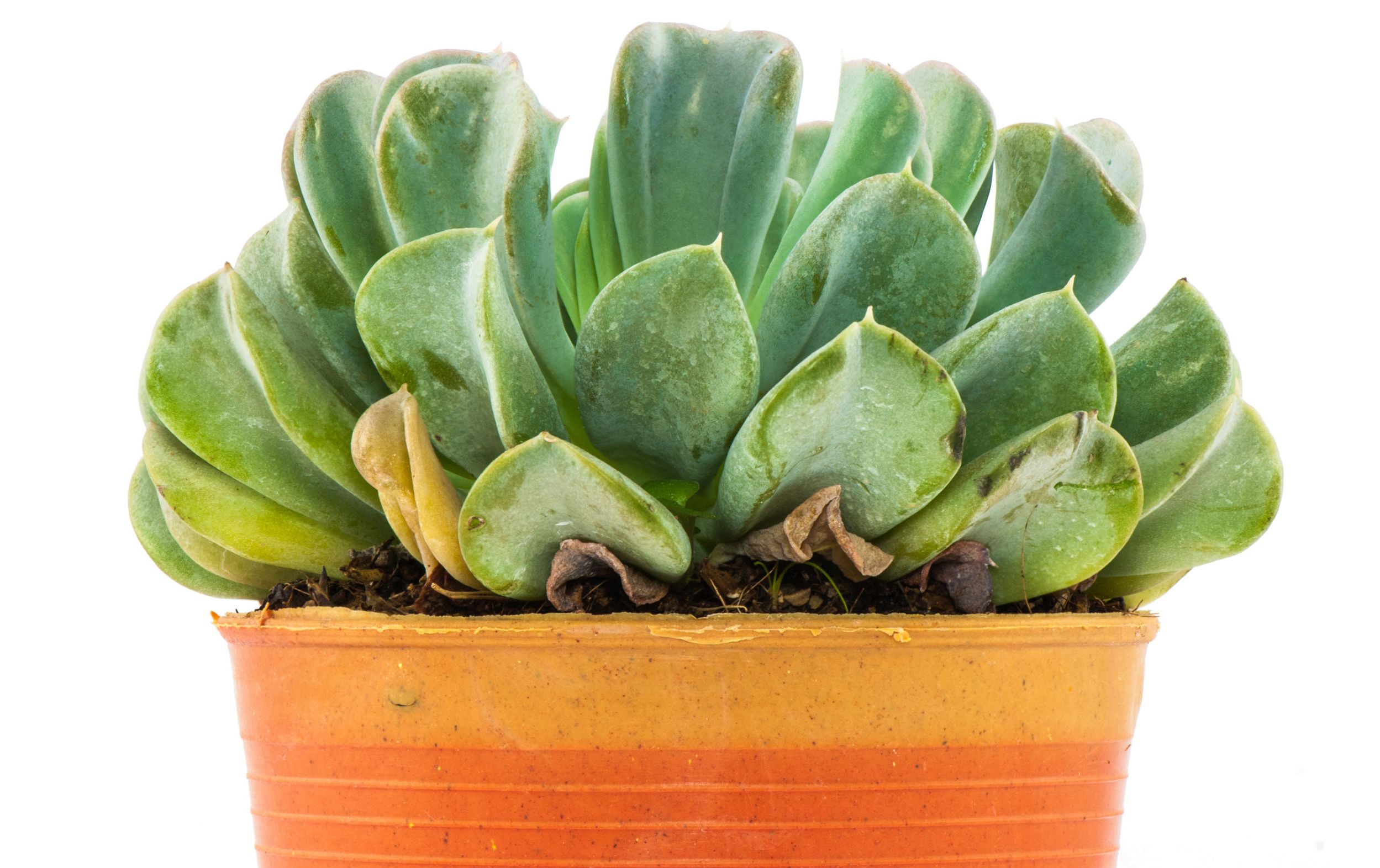
The Echeveria is a flowering succulent from the family Crassulaceae. It is native to semi-desert areas of Mexico, Central America, and the north-eastern part of South America.
Echeveria succulents grow from thick-leaved rosettes. Their colored leaves have a waxy cuticle on the outside. Firmly touching the leaves will leave marks and mar the skin. This is a slow-growing plant and will not be taller or wider than 12 inches.
Echeveria is among the most identifiable succulents. It comes in many shapes and colors. The blue/gray-leaved selections adapt better in low light conditions than the purple, pink, and green varieties.
It is essential that your turn the pot of your plant every few days to keep one part from stretching too far to one side due to lack of light.
Learn How to Propagate Echeveria Pups (or Babies or Offsets)
2. Snake Plant
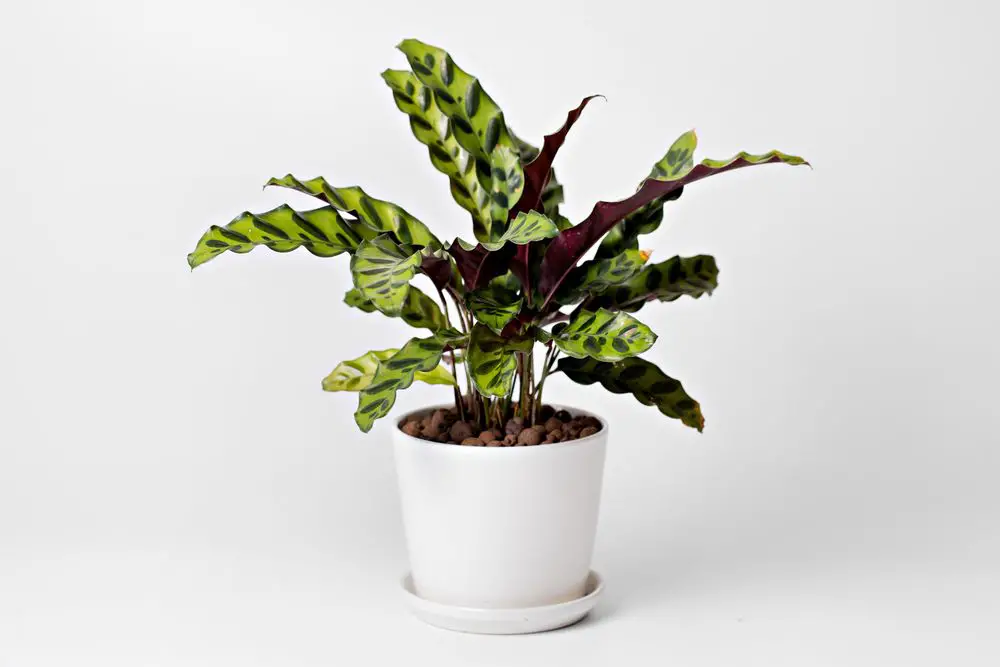
The Snake Plant (Dracaena trifasciata/Sansevieria trifasciata). This plant comes in a wide range of varieties most of which can grow up to 4 feet tall. The more compact varieties are just a few inches tall.
This succulent has flat, long sword-like green leaves. Depending on the variety, it may have various variegations and markings.
The plant needs only minimal watering. It also requires almost zero maintenance.
The Snake Plant grows and thrives best in bright light. It can also adapt to low light conditions but will have slower growth than when in bright sun.
The Snake Plant is among the strongest low light succulents. It is a common succulent for offices because they thrive even when neglected. This plant can survive even when watered only a few times a month and on whatever light shows up.
3. The Ox Tongue Plant
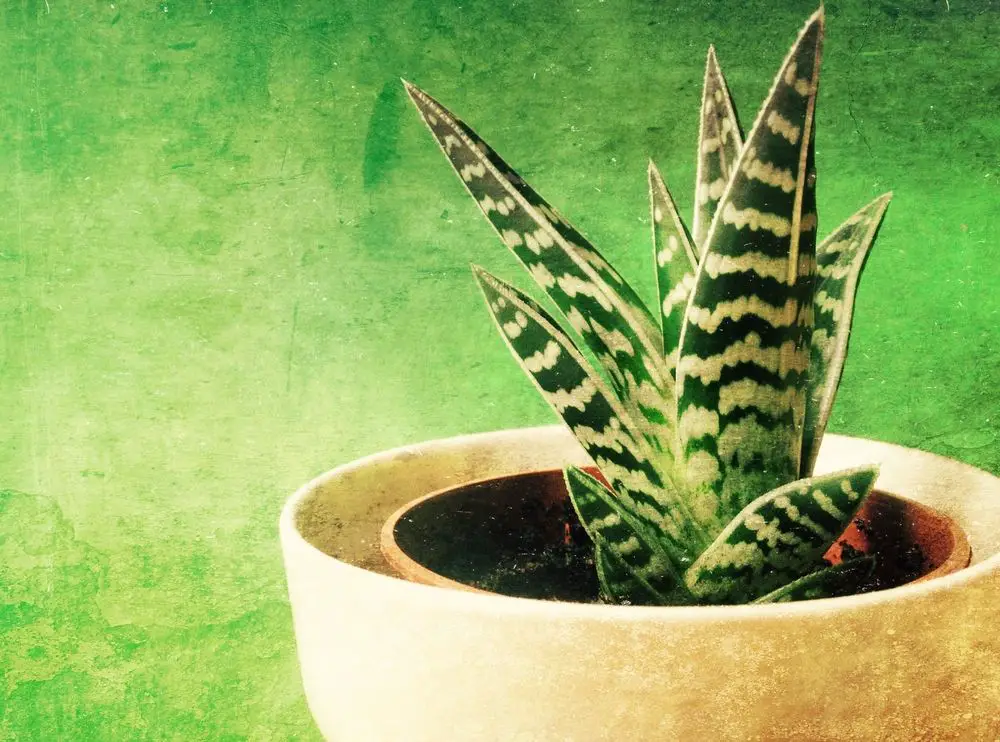
The Ox Tongue Plant (Gasteria prolifera) comes with thick, broad leaves with markings and patterns. The leaves emerge in pairs from the central growing point.
Ox tongues thrive in light shade so they can easily adapt to low light conditions in your home or office. Light coming from a sunny window is enough to keep the Ox Tongues happy.
Many growers of indoor plants say the Ox tongue grows well in cool rooms with limited light. You can, however, opt to take your plant outdoors during summer as long as you placed it in a shaded area.
Water only when the potting soil has completely dried out. They need less watering in the winter than during summer. Apply less fertilizer, too.
4. Lance Aloe
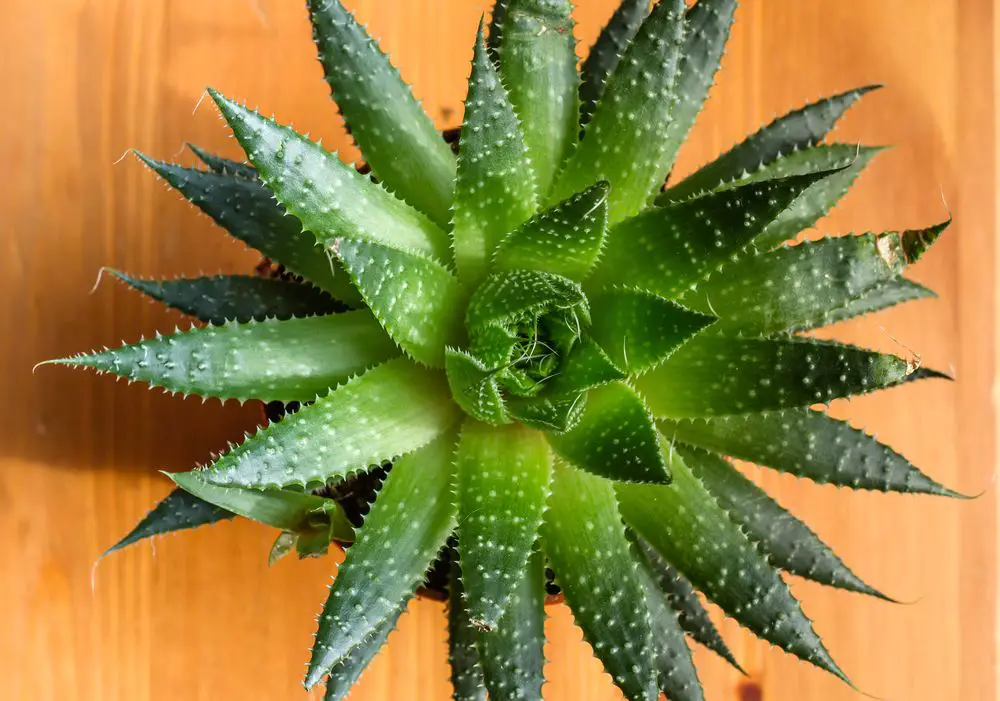
Lance Aloe (Aristaloe aristata, also known as the Torch Plant, is an evergreen perennial. This dwarf succulent comes with bright green and lanced-shaped leaves with some white spots. The tips of the leaves have soft white spines.
The Lance Aloe is a common succulent indoor houseplant that can be 15 inches wide and 8 inches tall. It grows tubular flowers that are red orange.
This low light succulent only needs 3-6 hours of sunlight per day. This should be enough light for the Lance Aloe to grow, thrice and prevent etiolation. It also needs only to be watered 1-2 times a week or when the soil looks or feels dry.
Make sure to plant this succulent in fast, well-draining soil to allow water to drain quickly to prevent overwatering and root rot.
The Lance Aloe thrives best in bright light but can also grow successfully in low-light areas.
Read more about the Lace Aloe (Aristaloe Aristata)
5. Zebra Haworthia
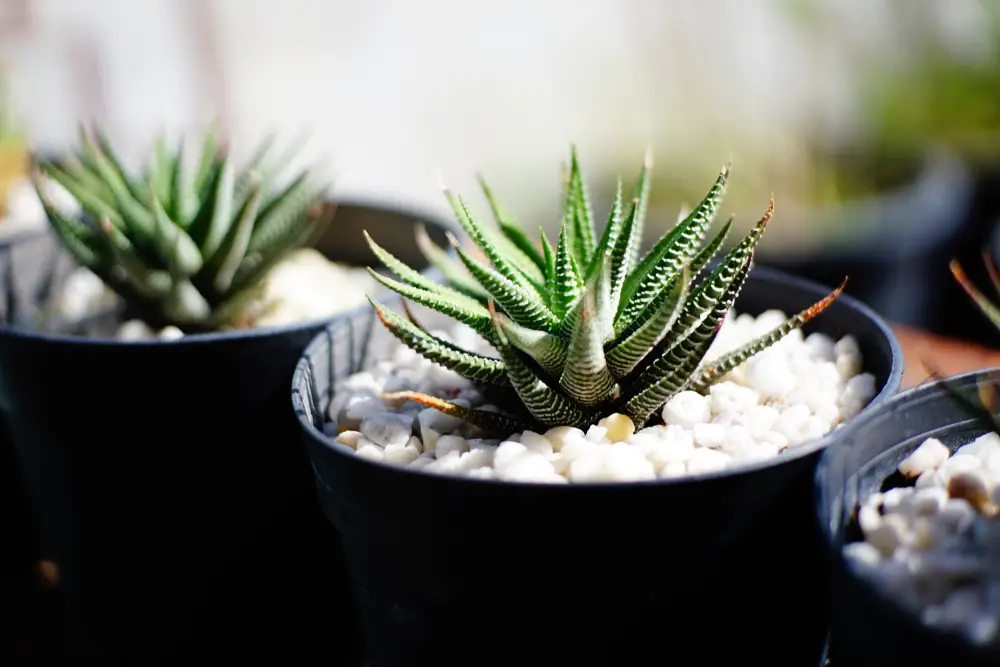
The Zebra Haworthia, commonly known as the Zebra Plant, is a perfect succulent for beginners. This succulent can grow and thrive in low light, high light, or anything in between.
The spiked, slender leaves of the Zebra Plant are green with white vines and mimic the look of petite aloe. It grows colorful blooms in the late summer or early autumn.
The Zebra Plant loves partial shade or indirect light because they are used to growing in humid and warm climates where they grow under tree shades. Direct sunlight can scorch the leaves of this succulent making it a good low light succulent. This plant will not bloom, though under a full shade.
This succulent is a slow grower and tends to lean in the direction of the sun when placed in low-light areas. Rotate the pot regularly to ensure your plant grows evenly.
6. Panda Plant
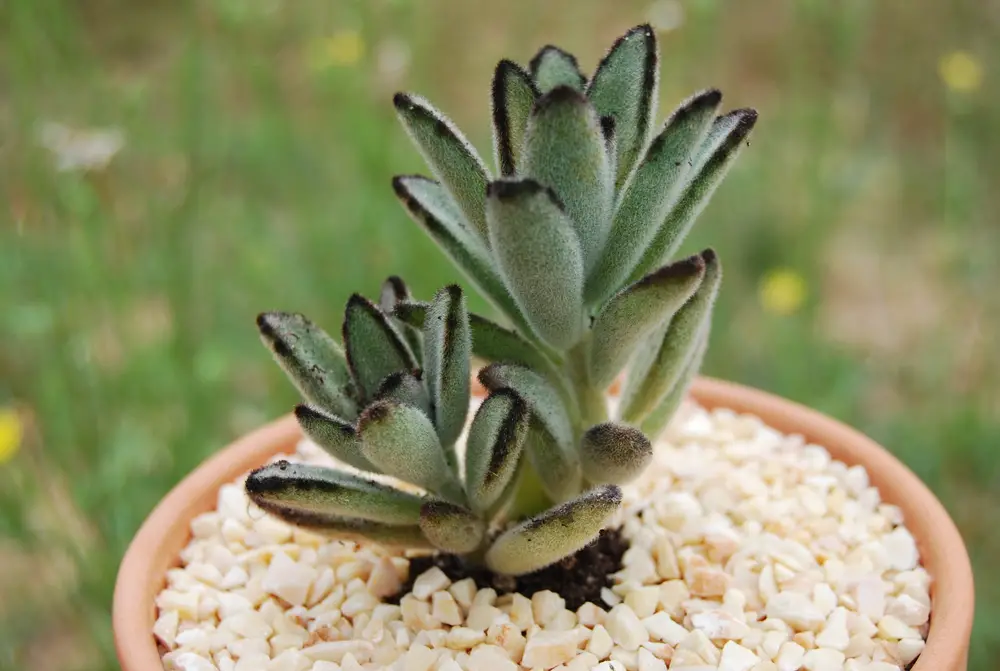
The Panda Plant (Kalanchoe tomentosa) is one of the best low light succulents that are easy to grow. It got its name from its grey-green leaves covered in silver white and fur-like hairs that are irresistible to touch and brown accents on the tips.
The stems of the Panda Plant are thick and tend to become elongated in low-light than in high-light areas. The Panda plant can, but rarely blooms indoors.
The Panda Plant can tolerate bright light, but it also loves the shade and can thrive in low light areas. It loves medium, indirect light the best for about 4-5 hours per day. Excessive sunlight can dry out the plant.
This succulent needs minimal water (only when the soil is completely dry). The soak and dry method is the best way to water this plant. Fertilize this succulent only in spring and summer.
The Panda Plant is susceptible to root rot so make sure to use a well-draining succulent potting mix and avoid overwatering.
The Panda Plant is an ideal succulent for beginners. It does not need much attention and care to survive making it one of the most popular office plants.
7. String of Pearls
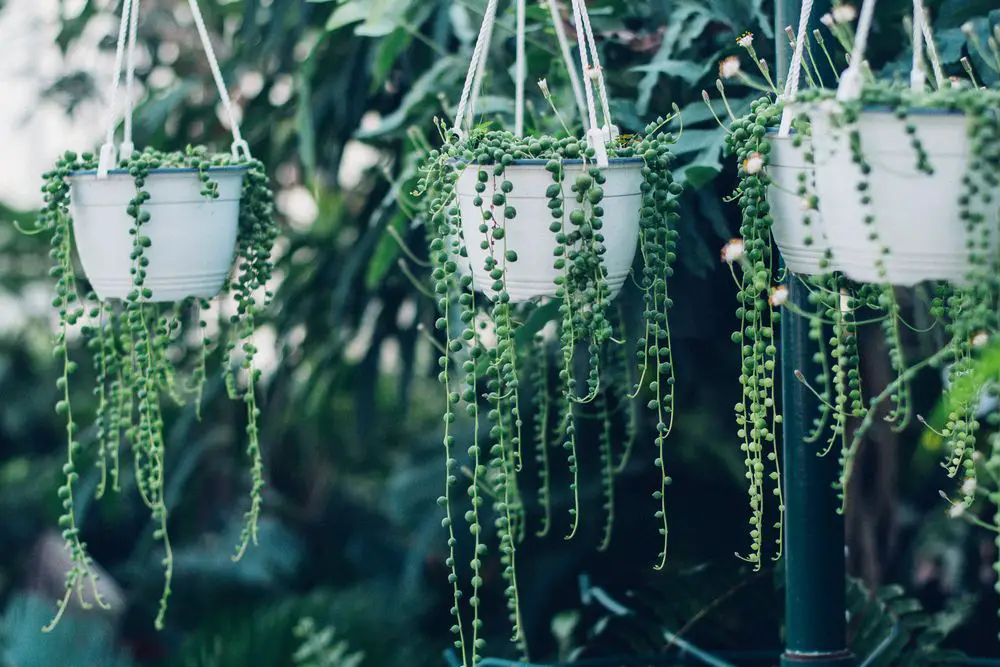
The String of Pearls (Senecio/Curio rowleyanus) is another of the hanging low light succulents. The leaves of this succulent grow out of thin hanging stems cascading down the sides of hanging planters.
Each stem of this succulent is covered in small, pearl-shaped leaves. It also grows white brush-shaped flowers.
You can also grow the String of Pearls in a pot, place it on a plant stand or bookshelf and allow its stems to trail to the ground.
The String of Pearls requires adequate sunlight but will dry up and shrivel when exposed to excessive sunlight. It will not do well in direct sunlight, full sun, or intense heat.
This succulent needs lots of morning sun and some indirect afternoon sun.
Adequate sunlight indoors works best for this succulent. A bright spot in your home or office with plenty of sunshine and light is ideal.
It is also best that the sun hits not only the leaves of the plant but its crown as well.
Not enough sunlight causes the String of Pearls to have dropped leaves and poor growth. Too much sunlight, on the other hand, will cause the plant to turn yellow.
Although the Spring of Pearls thrives best in bright, indirect light, it can tolerate low light conditions.
8. String of Hearts
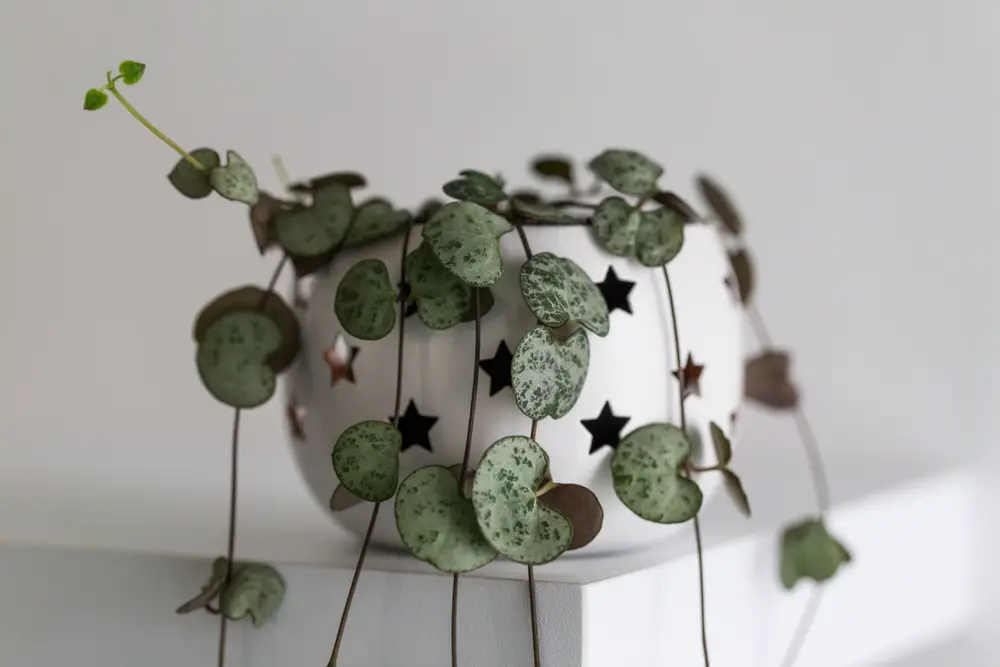
The String of Hearts (Ceropegia woodii) is an evergreen, succulent, hanging plant that comes with heart-shaped variegated leaves trailing from wiry, thin vines.
This unique, beautiful, and easy-to-grow houseplant grows tubular pinkish flowers, which have a round base and form into enclosed beads. Thus, this plant is also referred to as the Rosary Vine.
The flowers bloom the most in the late summer and fall but also appear throughout the year.
It is ideal to grow in hanging baskets or pots that you can place on window sills and shelves. The String of Pearls is a fast-growing succulent with vines that can hang down several feet.
The String of Hearts can thrive in high and low light environments. It will only bloom though, with ample sunlight.
Water the String of Hearts consistently once or twice a week during the spring and summer. Water the plant every two weeks during the fall and winter when the plant is dormant.
Avoid overwatering the String of Hearts as it will develop yellow leaves and root rot. This succulent store water in its leaves so it can survive dry conditions.
Read more About Planting and Caring for Variegated String of Hearts
9. String of Bananas
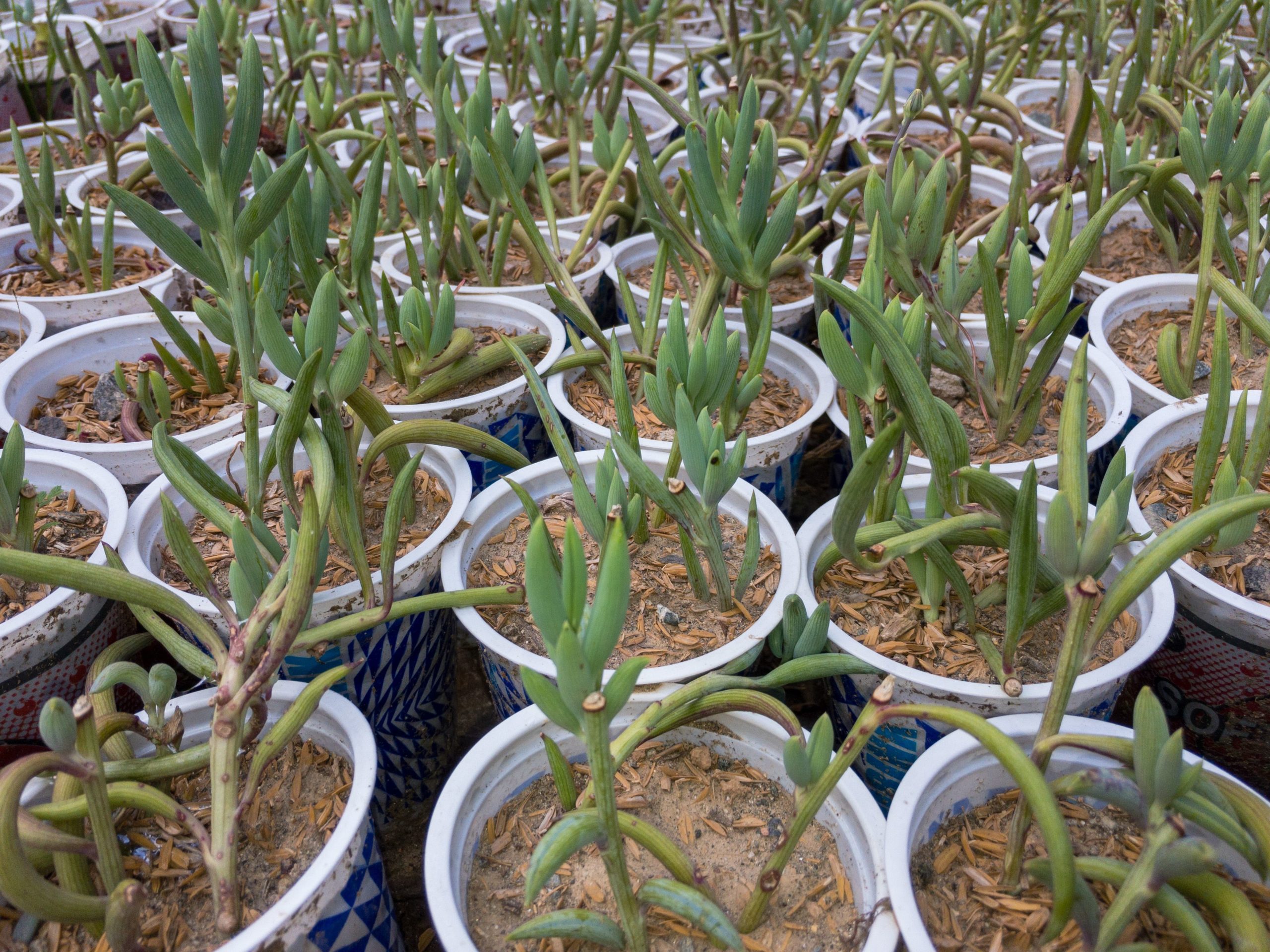
The String of Bananas (Senecio radicans) is a hanging houseplant that can thrive in low light conditions.
The String of Bananas is perfect for growing in hanging baskets indoors. It grows best in well-draining and porous soil. If you are growing Strains of Bananas in pots, make sure the pots have draining holes.
This succulent has vibrant leave lining its stems in the shape of bananas. It can tolerate drought. It blooms clusters of white flowers in the late fall or early winter.
You should water it only when the soil is completely dry which should be once a week during spring and summer and about every two weeks during fall and winter. Overwatering can cause the plant to develop because root rot.
It is best to place your String of Bananas in bright, indirect light. This means near a sunny window in your home or office. But it will thrive as well in low light areas.
Read more: How to Grow and Maintain String of Bananas (Senecio Radicans)
10. Burro’s Tail
Burro’s Tail (Sedum morganianum) is a drought and heat-tolerant succulent. It can grow in any type of soil that has good drainage.
The Burro’s Tail is a trailing succulent that likes ample light but can easily adapt to low light environments. It prefers to be watered more during the summer and less water during winter. Be careful not to overwater as this succulent will develop root rot.
The dusty green leaves of the Burro’s Tail retain water and form densely along its stems. Its stems trail over the sides of hanging planters and pots.
This succulent is fragile and its leaves and stems easily fall off when touched so place it in a low traffic area. You can, however, just pick up the leaves and plant them anew and they will easily grow into a new plant.
11. Holiday Cacti
The Holiday Cacti (Schlumbergday Cacti era truncata and S. x bukleyi) love a humid environment but they can do fine even without plenty of sunlight. These plants are epiphytes, so they naturally live under trees that give them protection from the sun.
The Holiday Cacti is also known as the False Christmas Cactus, the Thanksgiving Cactus, and the Crab Cactus. All of them are low light succulents.
This means they do not need lots of light to grow and thrive. The lack of light promotes the production of blooms, especially in autumn.
The Holiday Cacti have gorgeous blooms. Unlike most succulents, they need to be watered regularly but they should never be overwatered.
12. Wax Plant
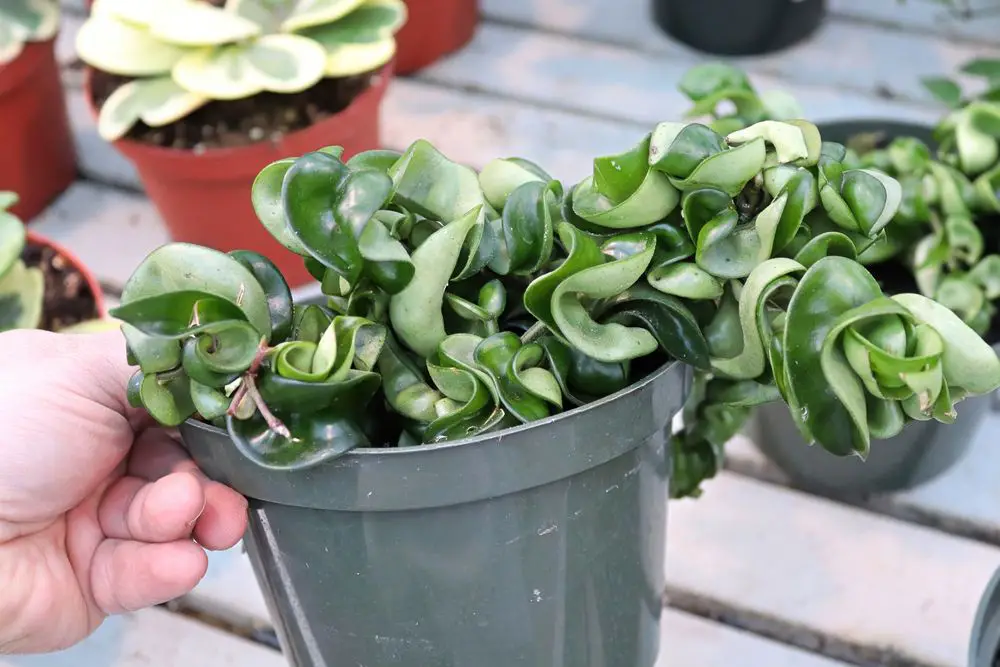
The Wax Plant or Hindu Rope (Hoya Obovata) is a succulent with thick and almost heart-shaped leaves. It is important to note that there are some Hoya species that are not succulents but species that are succulents that do not need direct sunlight.
This succulent thrives in partial shade and beautifully grows in hanging baskets indoors. It thrives best in indirect sun and can easily adapt to low-light conditions.
This Wax Plant variety needs humid and lightly moist and well-draining soil. Water the plant only when its soil is dry.
Hoyas are easy-to-grow and care low light succulents if they are not overwatered. Overwatering leads them to develop root rot. They are great trailing plants that can grow over or up a window.
13. Bear Paws
Bear Paws (Cotyledon Tomentosa) can be an unusual entry into this list of low light succulents because it prefers direct light. The unusual growth pattern of the Bear Paws, though, does not make etiolation that is common in low-light conditions noticeable.
The Cotyledon Tomentosa is called Bear Paws because of its thick, blurry leaves and rigged “claws.” It can grow and thrive in full sun to partial shade. Water your plant sparingly. Its soil needs to be dry before watering.
The Bear Paws produces orange flowers in spring when it gets enough sun.
14. Jade Plant
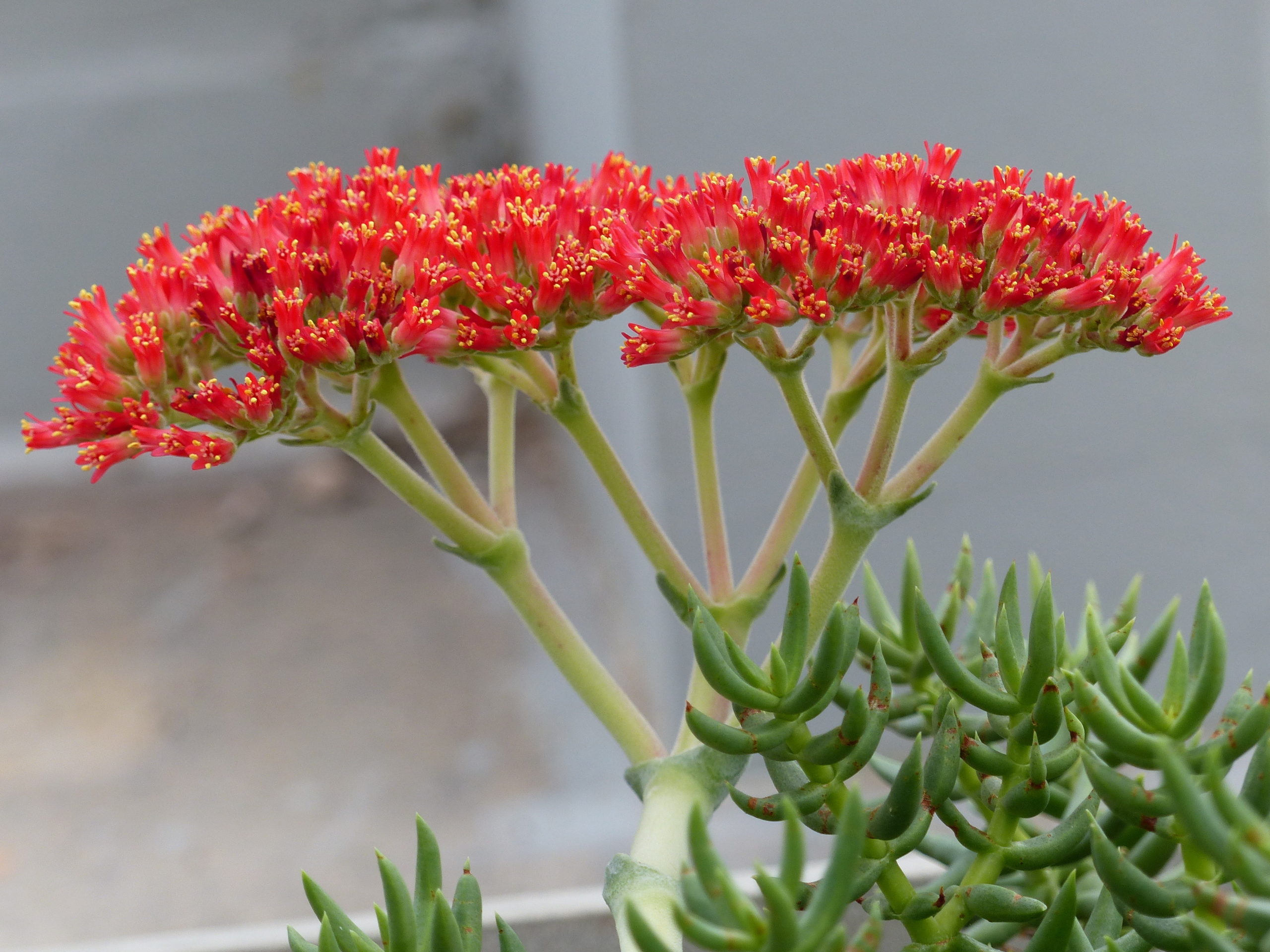
The Jade Plant (Crassula ovata) comes with tough and trunk-like shoots. This succulent can easily adapt to a wide range of light conditions including full sun, partial shade, and low-light conditions.
Low-light conditions allow the Jade Plant to look healthy while allowing it to maintain its texture and structure.
The Jade Plant had glossy green leaves that retain moisture; thus, it does not need much watering. Water the plant when its leaves start to fall and wither. When the leaves are glossy and plump, no watering is necessary.
The Jade Plant is typically red or green. Its color depends on the amount of sunlight it gets.
The Jade Plant is one of the best low light succulents for your home or office. This succulent is also associated with prosperity, fortune, and luck.
15. Mother-in Law’s Tongue
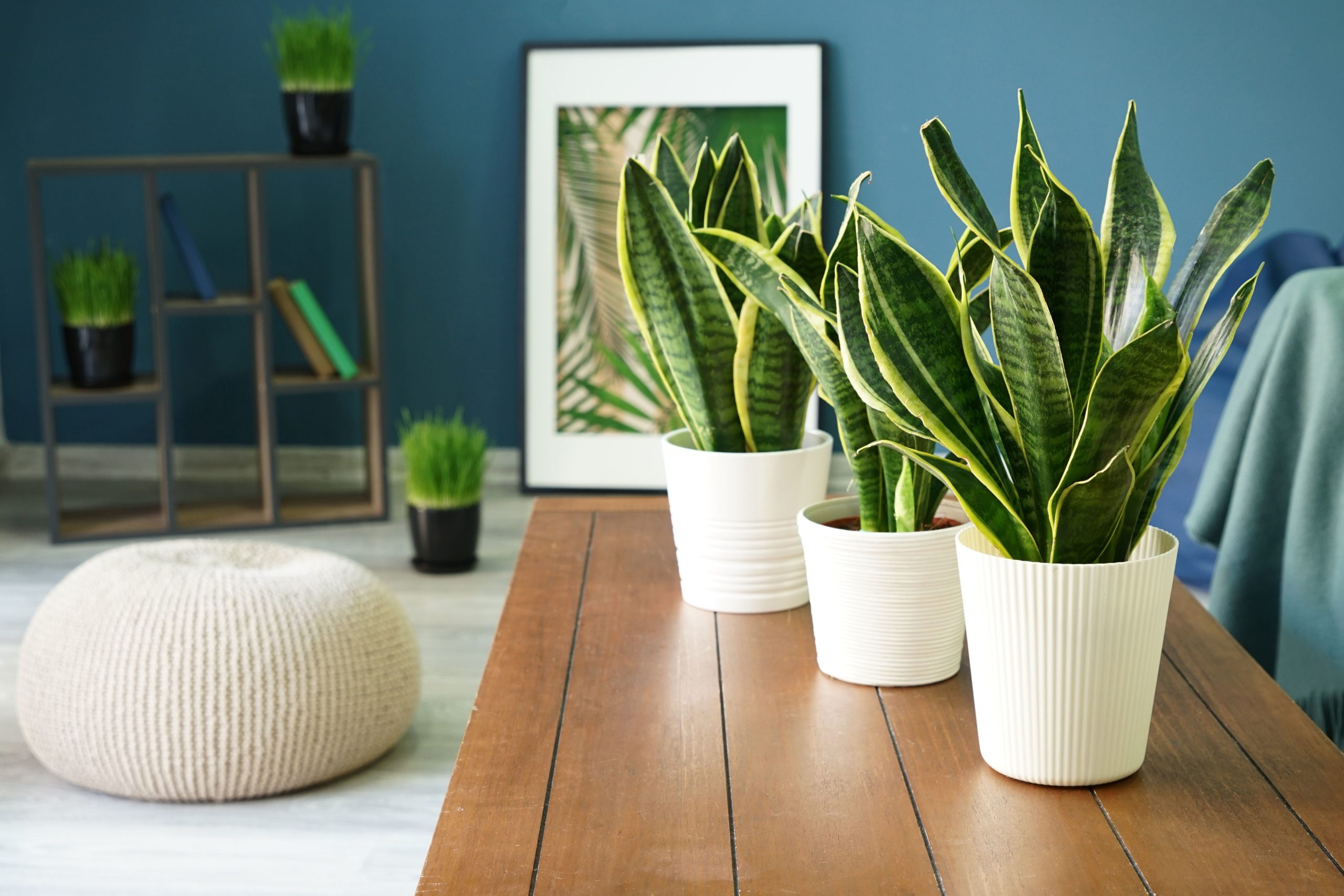
The Mother-in-Law’s Tongue (Sansevieria trifasciata) is considered the star of all low light succulents.
This succulent comes with upright, narrow-pointed leaves in a clustered formation. It creates a wonderful display in low light areas.
The Mother-in Law’s Tongue is a versatile succulent because it can thrive in low light through filtered light, and even in direct light environments. It only requires moderate watering during its active growth phase. It requires less water during the colder seasons.
Read more: Do Snake Plants (or Mother in Law’s Tongue or Sansevieria) Like Humidity?
Read more: Mother In Law’s Tongue (Sansevieria) — The Ultimate Guide
16. Zebra Cactus
The Zebra Cactus (Haworthia attenuata) is a staple succulent arrangement in many office cubicles. It is a slow-growing succulent that requires infrequent watering and can thrive in whatever light is available.
The Zebra plant comes with green, pointed tip leaves with white marks on the edges or all over the leaves.
The Zebra Plant loves low-light or indirect, filtered light. It is best grown in a soil-based potting mix, so it does not need to be applied with fertilizer. If it is not grown in a soil-based medium, it needs to be fertilized with a standard liquid fertilizer fortnightly.
17. Ponytail Palm
The Ponytail Palm (Beaucarnea recurvata) is another surprise entry to the list of low light succulents because many believe that it is not a succulent.
Succulents are not a specific plant family but instead refer to plants that store water. The Ponytail Palm is a succulent and not a palm tree-like plant as most people think.
The Ponytail Palm has a round pump where it stores water, thus it is categorized as a succulent. This succulent should be grown in well-drained soil. It can survive up to three weeks without water because its leaves can store water.
This slow-growing succulent comes with long, thin, and hair-like leaves. It can tolerate low light conditions.
18. Mistletoe Cactus
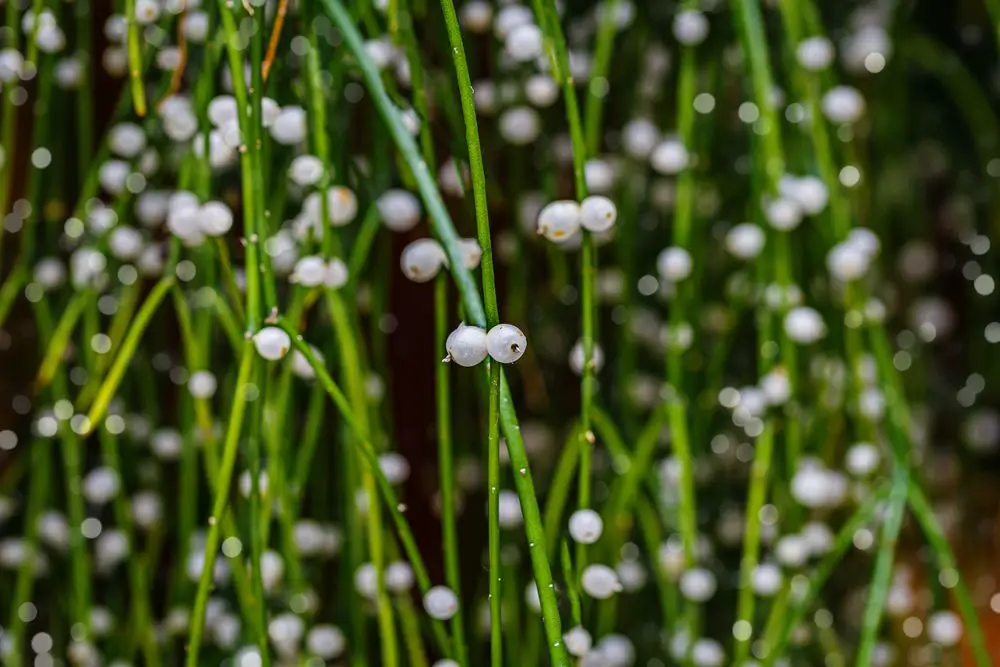
Mistletoe Cactus (Rhipsalis baccifera) is a unique type of succulent because it is an epiphyte (a plant that grows on another plant instead of on the ground but is not a parasite). They grow in the crevices of trees instead of soil, but they are not connected to the tree.
The Mistletoe Cactus grows and thrives in low light conditions because they love full or partial shade. It comes with cylindrical stems and produces clustered flowers.
This succulent is best placed in an area where it can receive morning sun and a deep afternoon shade. It prefers slightly acidic soil that is well-draining. You can show off its long stems by placing it on a pedestal or high up on a shelf.
19. Green Ice
The Green Ice (Gasteraloe) is part of a collection of hybrid succulents. It is a cross between Gasteria and Aloe).
The Green Ice comes with greyish-green leaves that have grey stripes and spots. It is a great indoor plant because is slow-growing and can very well tolerate low light conditions.
The Green Ice loves low-light or indirect filtered light. Move it to an where it will receive more light when its leaves start losing their variegated effect. It does not need to be watered often but when you do, give the plant a good soak.
This succulent is a gorgeous desk plant. It will also look good on a dark shelf in a north-facing room, balcony, or patio. It will produce flowers when exposed to filtered light.
20. Aloe Vera
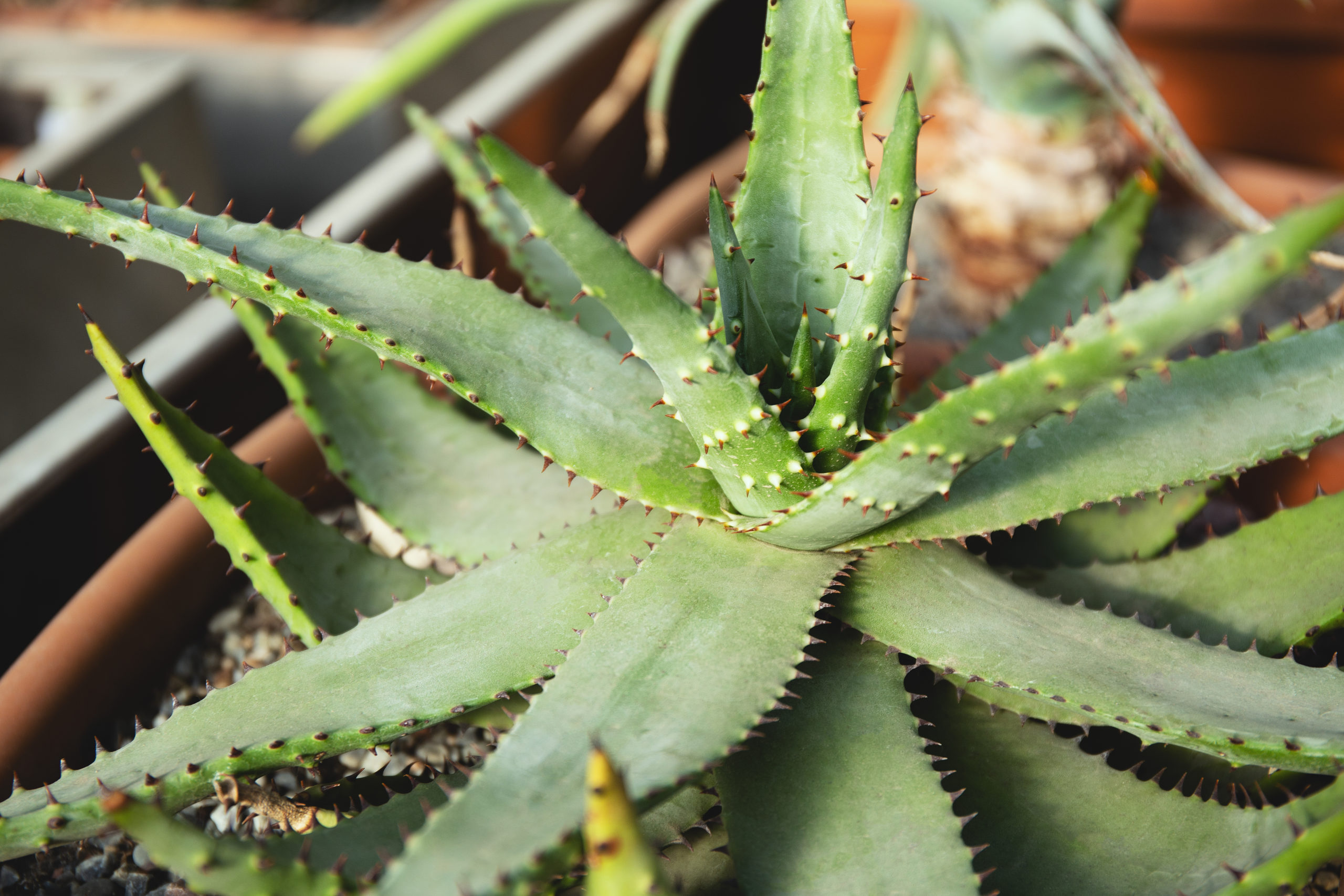
Aloe Vera (Medicinal Aloe, Barbados Aloe) is the most popular aloe. It is also the most popular succulent and plant in the world because it is simple to grow even if you do not have a green thumb.
The Aloe Vera will survive in any home or office light including low-light environments. It will even survive on any windowsill.
The Aloe Vera thrives in bright, filtered light. A small indoor light will keep it looking fleshy and fresh in low light areas. It only needs to be watered once a week making sure its well-draining soil is completely dry between watering schedules.
Read more: Growing and Maintaining Tiger Tooth Aloe (Aloe Juvenna)
21. Happy Bean
The Happy Bean (Peperomia ferreyrae) is a small succulent with lime-green, thin bean-shaped leaves. Happy Bean is one of the most popular low light succulents.
This succulent can tolerate light conditions ranging from low light and filtered light indoors, or partial light outdoors.
This petite succulent is ideal for limited spaces in your home or office because it can be about 6 to 8 inches in height.
Care Tips for Low Light Succulents
Low light succulents thrive well in areas that receive bright indirect light and, ideally, receive the morning sun. Can succulents thrive in low light conditions or in areas where they can only receive minimal sunshine?
If you are a succulent lover with a budding collection, you may be wondering if you can decorate dim areas in your home with gorgeous succulents.
It is true succulents are sun-worshipping plants because most succulents come from arid and hot parts of the world. Placing all your succulents in ideal spots such as sunny windowsills will crowd them all in one spot.
Low lighting conditions are not a hindrance to growing succulents in your home or office. It may have some challenges, but with these care tips, you can be successful in growing succulents in low light areas.
Here are the best tips to successfully grow succulents in low light.
Choose the Right Type of Succulent.
Not all succulents can survive in low light. Do some research and pick succulents that can thrive in bright, indirect light instead of bright, direct sunlight.
While there are succulents that thrive in low light conditions, they will not thrive without light. They can put up with low light conditions but should not be permanently left in sun-deprived areas. After a couple of months, you may notice some signs of stress in your succulents.
Stressed succulents may turn yellow and pale. They may also have a tall, thin growth because they will grow upwards and search for some light. It is, therefore, essential to also expose your succulents (rotate in a brighter condition) to bright, direct sunlight every few months.
Choose a Pot with Drainage Holes
The roots of your succulent should not hold moisture, or it may develop root rot. You should use a pot with drainage holes.
Use a Well-draining Potting Mix
Good drainage is key to successfully growing succulents. Succulents cannot thrive in high moisture soils. Water-absorbing materials such as pumice or perlite are well-draining and ideal for succulents.
Use Nutrient-Rich Soil and Less Fertilizer
Succulents do not need much fertilizer. They store nutrients and water in their stems or leaves. They grow faster in nutrient-rich soil.
Low light succulents need to be grown in nutrient-rich soil to prevent them from appearing etiolated (drawn and pale because of lack of light).
Apply fertilizers only once a month.
Water Succulents Sparingly and Direct to the Soil
Do not water your succulents often. Low light succulents are not exposed to direct sunlight, thus excess water will not be absorbed.
Water directly to the soil, too. It is more effective than spraying your succulent. You can use the indoor plant tablespoon watering method. This method entails using a tablespoon to directly water the soil.
The number of tablespoons needed to water the soil of your succulent depends on the size of the pot, climate condition, and dryness of the soil.
Water when the Soil Dries Out
Check the surface of the soil before watering. One to two inches of the soil should be wholly dried before watering.
Low light succulents have a darker green color than the high light ones. They also look more aloe-like than flower-like. These succulents do not come in vibrant colors but they have beautiful shapes and textures.
Allow your Succulents to get Bright, Filtered Light
Your succulents will thrive in low-light areas if you move them to an area where they can get bright, filtered light now and then. You may also opt to move it to an area with grow lights.
Exposing your low light succulents to extra light for about a week and returning them to low light will extend its life and keep them from looking scraggly and pale. This should be done during the growth stage of your succulent.
Benefits of Growing Succulents
There is more to succulents than just being beautiful and incredible home and office decors.
Improve Air Quality
Succulents can clean the air in your home or office. Succulents such as snake plants and aloe can remove toxins from the air.
These plants have pores that absorb gasses in the air including ones that are harmful to breathe. So, some succulents can replace air purifiers.
Succulents can also humidify the air and improve air quality in your home or office. The pores in their leaves can release water vapor during photosynthesis to add extra moisture to the air to prevent it from getting too dry.
Improve Concentration
Keeping succulents in your office desk can boost your concentration, focus, and productivity.
Reduces Stress
Plant lovers swear that taking care of plants reduces stress. Coming home after a hard day at work and tending to your plants can help you recover from anxiety and worry, calm you down, and reduce your blood pressure.
Succulents are easy to care for and, more than any other houseplant, they can easily reduce your stress.
Medicinal Properties
Succulents have been used for hundreds of years to treat medical problems such as stomach aches, burns, cuts, and more.
Some succulents are also edible and can make healthy snacks.
What Does “Low-Light” Mean?
In growing succulents, it is essential to determine direct sunlight, indirect light, low-light conditions, and filtered light.
Direct Sunlight. This means there are no obstructions between the sun and the plant.
Indirect Light. This is the outdoor condition when the sun is bright and sunny.
Low-light Conditions. This refers to areas that are away from window sills (a shelf, desk, or dining table).
Filtered Light. This refers to light that passes through a window sill when indoors and under a tree. When in a low-light area, filtered light does not refer to direct sunlight during the day.
“Low light” does not mean “no light.” Low light, in relation to areas where succulents can thrive, refers to shaded outdoor areas, or areas that are far away from windows indoors.
Low-light areas refer to north-facing windows. It may also refer to rooms darkened by shadows from other buildings and trees. Bright, filtered light is not considered low-light.
Final Thoughts on Low Light Succulents for Home or Office
You can grow some succulents indoors without having to worry about low-light conditions in your home or office. Always remember that low light doesn’t mean your succulent won’t receive any sunlight.
When you want to fill your home or office with succulents, you will eventually run out of window space for your plants.
There are low light succulents you can display in places that don’t have sunlight. You can put them on a bookshelf, tabletop, desk, or bedside table. You can also opt for flowering succulents or those that beautifully grow in hanging baskets.
Give succulents a chance – ‘they grow on you’.

